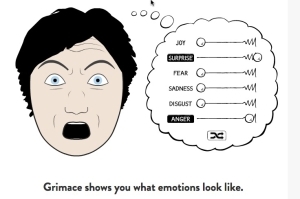Rosina Lippi's Blog, page 17
July 27, 2015
Pig in a Poke, revisited: Amazon Shenanigans
The first version of this post went up in January 2013. I’m revising and reposting it because Amazon is bungling editions, in a rather deceptive and (to me) infuriating way. The update is followed by the original post.
Amazon has a newish feature I actually like, called Kindle Match. If you bought a hard copy of a book from them in the past — and it can be way, way past, fifteen years ago even, you may be able to get the Kindle edition for anywhere between nothing and ten bucks. Most of the titles seem to be at $2.99 or less.
So I was looking through this list and I come across the fact that I bought the Norton Critical Edition of Price and Prejudice in 2006. Why I did that is a different question — I can’t remember why I wanted yet another copy. But as you see here I did indeed buy it in 2006:

Kindle Match
A critical edition is the queen of all editions for any book that is considered classic, and the subject of study by academics and scholars. Wikipedia provides a concise description of how critical editions come to be:
Textual criticism is a branch of textual scholarship, philology, and literary criticism that is concerned with the identification and removal of transcription errors in texts, both manuscripts and printed books. Ancient scribes made errors or alterations when copying manuscripts by hand.[1] Given a manuscript copy, several or many copies, but not the original document, the textual critic seeks to reconstruct the original text (the archetype or autograph) as closely as possible. The same processes can be used to attempt to reconstruct intermediate editions, or recensions, of a document’s transcription history.[2] The ultimate objective of the textual critic’s work is the production of a “critical edition” containing a text most closely approximating the original.
Critical editions almost always have additional materials: essays by the editors and/or other scholars, about the book and its history, the author, the time period, and anything else you can think of. There will also be footnotes to clarify terms that may not be familiar to a current day reader. Given all this, it probably won’t surprise you that a critical edition costs more than the run-of-the-mill edition.
To clarify what I mean by ‘run-of-the-mill’ edition (or see this post, in which I was totally cranky, but still on target):
Because P&P is long out of print and copyright, anybody can put out a new edition without paying the author or the author’s estate anything. The result is many, many hundreds of editions of P&P put out on cheap paper, with little or no attention to the quality or accuracy of the text, all in the hope of a bit of a profit. You can find new copies of this novel for a buck, and then used copies of that same edition for a penny.
Do I want the Norton edition as a Kindle book? Need you ask? So I click on the “Get Kindle Edition” button you see, and this is what comes up:

Not the Norton Critical Edition
Here is what the page for the critical edition actually looks like:
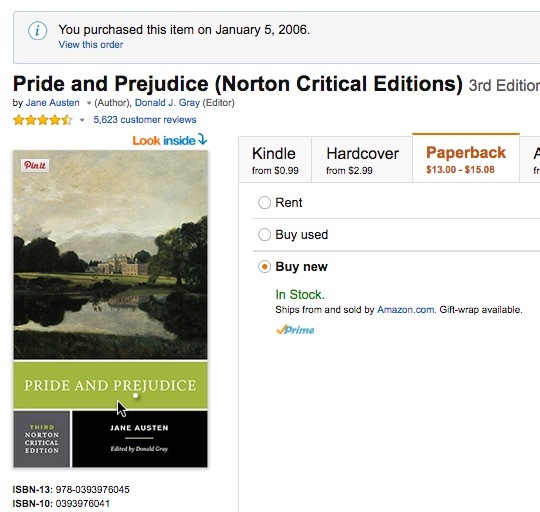
This is the real Norton Critical Edition
You see that the critical edition has an editor (Donald J. Gray) and also that I bought it in 2006. But what I was offered as a part of Kindle Match was a crappy movie-tie in edition, one I never bought in soft cover.
To take this one step further (because it gets worse), if I click on the “Kindle Edition” tab on the Norton edition page, this is what I get:

Still not the critical edition
Note that this was not published by Norton, but by “Top Five Classics” — one of the many companies that specialize in run-of-the-mill cheap editions. At this point it occurs to me that there may not even be a Kindle version of the Norton Critical Edition, so I pop over to the Norton website and have a look at the P&P page. And in fact, it’s only put out in trade paper format. (Click on the link if you want to see what all goes into a critical edition.)
In a nutshell: if I pay for the critical edition, I want it. I want it for all the reasons touched on above. If another reader doesn’t care about the edition, s/he won’t even notice the switch. But people should care, because the practice is (a) deceptive and (b) wasteful. I hate to think of all the paper that has gone into crappy editions of this particular novel, one of many. My guess is that you could repeat this process I’m showing you for everything from Gulliver’s Travels to A Room with a View.
Here’s the question: Is Amazon just tremendously sloppy and unwilling to pay attention to something as simple as an ISBN, or is this a way to lure in less-than-attentive buyers?
One of the first things you learn in graduate school is to never walk into a seminar where a particular novel is going to be discussed holding a movie-tie in edition rather than the critical edition. You will not be treated kindly. Also, it’s disrespectful to the editors who put in years of work to make sure the edition is as authentic and error free as possible.
So I’m done venting. I doubt anybody at Amazon will pay attention to my squeaking, but I’m going to keep an eye on this.
January 2013 Post:
I love all things electronic, but when it comes to buying and selling books on the internet I see room for improvement. To be fair, that improvement is coming along nicely. In most areas.
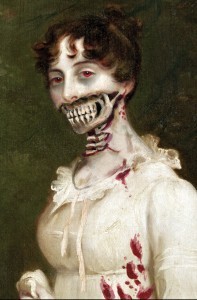
Don’t make Jane angry. You wouldn’t like her when she’s angry.
I’ll demonstrate with (what else?) Pride & Prejudice. There must be a couple hundred editions of P&P in English alone. Poorly done editions, leather-bound editions (and sometimes those two things aren’t mutually exclusive), editions on paper so cheap it makes your fingers itch just to turn the page, critical editions (put together by academics with special care to detail and authenticity), abbreviated and illustrated and annotated editions. Most people don’t realize how different editions can be, or that one might be better than another. If you’ve read one copy of Pride & Prejudice you’ve read them all, is the general belief. This is a widely held misconception, and one that technology is not doing anything to rectify. Just the opposite.
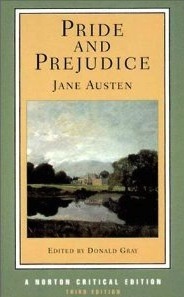 Before Amazon if you wanted a specific P&P edition (say, with illustrations by a particular artist, or edited by a particular Austen specialist) you could usually track it down, sometimes easily and sometimes not so. In the present day finding and buying books is infinitely easier, but distinguishing one edition from another is far harder, and sometimes almost impossible.
Before Amazon if you wanted a specific P&P edition (say, with illustrations by a particular artist, or edited by a particular Austen specialist) you could usually track it down, sometimes easily and sometimes not so. In the present day finding and buying books is infinitely easier, but distinguishing one edition from another is far harder, and sometimes almost impossible.
Consider a few of the numerous editions of P&P. The one on the left is the Norton Critical edition that’s currently in print, which is most likely the edition you would be asked to read in a serious advanced literature course. They used the original 1813 edition for the text, and it includes biographies of Austen by members of her family and specialists, as well as Austen’s letters, samples of her early writing, and tons of other bits and pieces. Note there’s another Norton Critical edition with a lovely teal cover, which happens to be out of print — but even if you found it for two bucks on a sale table, you’d be buying something different than the edition above. But how could you know that? Aside fr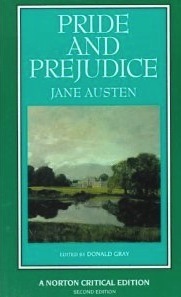 om comparing them side by side (books in hand), you’d be hard pressed to figure it out.
om comparing them side by side (books in hand), you’d be hard pressed to figure it out.
If this isn’t complicated enough, consider the Cambridge University Press edition, below. Note the following things: the name of the editor, the ISBN number, the fact that it is 622 pages long (the Norton Critical edition is 423 pages) and the whopping big price tag. The description doesn’t go into as much detail as the Norton edition. So which one is better, truer to the original, with better notes and annotations and essays? The page count and the price tag on the Cambridge edition might influence you. Your Aunt Ruth’s birthday is coming up. She is a Janite of the first order and she would want everything there is to know, so you spring for the expensive version.

CUP Edition
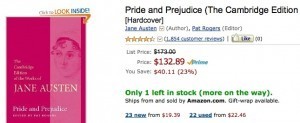
Amazon
Or you try to. Because this is where the real problems start, when you toddle off to Amazon to find a copy of the expensive CUP edition. It comes up without a hitch (as seen here), same cover, same title, same editor. And look at the huge discount…. even better, on Amazon Marketplace there are other copies for sale, for less than twenty bucks, even.
Remember that old chestnut about things too good to be true?
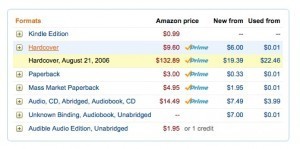 Have a closer look at the pricing information. What should jump out at you is that there’s a kindle edition. Really? A kindle edition of the 600+ page Cambridge University Press version, for less than a dollar?
Have a closer look at the pricing information. What should jump out at you is that there’s a kindle edition. Really? A kindle edition of the 600+ page Cambridge University Press version, for less than a dollar?
The confusion stems from Amazon’s misleading layout. They show you prices not just for the CUP edition, but for all editions. The Norton editions, Penguin, and every crappy edition ever put out by Barnes & Noble (Get five classic novels for ten bucks!). You don’t realize this, and money is money, and who are you to turn down a deal? You order a copy that’s priced at $25 and sit back to wait.
Now, if you took the time to follow the links you’d see that what you just ordered is not the CUP edition you wanted. But probably you didn’t take the time — why would you? So when the package comes you are not going to be happy. I would like to tell you that the bad news ends here, but there’s another wrinkle, one you wouldn’t find out about it until too late — unless you read through the reviews before you ordered.
A very kind reviewer (who calls him/herself Kiwi) went to the trouble to explain why you have to be careful ordering this book, even if you order the full priced version from up top. You can read the whole review here, but here’s the abbreviated version:
Check the Publisher carefully before you place your order because….,
One of the versions listed is published by “General Books LLC.” Another reader complained about the tiny and almost unreadable font – you probably bought the version published by General Books LLC – and here’s the reason.General Books LLC is an imprint of VDM Publishing, (google them and take a look at the Wikipedia article on them) and they specialise in publishing books that are free of copyright without doing any editing or quality control. […]
So what you’re getting if you buy the version published by General Books LLC is a scanned in, unedited, low quality […] unindexed / No table of contents book at a higher price than many of the good quality imprints available. Basically, VDM Publishing is flooding Amazon with these low quality prints (450,000 of them are listed now) publisher.
and, unfortunately, many of them have the reviews associated with better quality imprints associated with them. The product description is insufficient for the buyer that’s not aware of thisTotally unethical marketing.
‘Buyer beware’ doesn’t really say it strongly enough.
There are book sites that do an excellent job of distinguishing between editions. LibraryThing really works hard on this, but they don’t sell books; and they aren’t worried about a profit. They are concerned with compiling the best, most complete information, book by book, for people who care a lot about books.
Where do ebooks fit into this whole picture? I’ll tackle that question sometime soon.
I’ve been working on this post on and off for a long time, and finally decided to post it today. I finished the corporate taxes, and this is my reward. Really. It’s the INTJ in me, I can’t help it.
Tweet

July 26, 2015
Gesture & Facial Expression
In the past I’ve posted quite a lot about how challenging it is to describe both expressions on the human face and body language. Here’s a website that makes it somewhat easier to capture what it is you’re trying to describe.
What’s especially useful here is the ability to use the sliders to get gradual shifts. There is also quite a lot of information about the research that went into writing the program. I’m afraid I’ll be spending a lot of time here.
Tweet

July 23, 2015
Not quite all my worldly goods: Giveaways
 Things were easier when I could concentrate on this weblog alone. Now I’ve got Facebook and Twitter to juggle as well, and I am not so flexible with juggling these days. So in case you are as confused as I am, this summary:
Things were easier when I could concentrate on this weblog alone. Now I’ve got Facebook and Twitter to juggle as well, and I am not so flexible with juggling these days. So in case you are as confused as I am, this summary:
Here on the weblog I am running a big contest (the biggest ever, by the way) – go have a look
On the Sara Donati Facebook page there’s a contest going to win a signed manuscript page from The Gilded Hour
Next week on Twitter there will be a giveaway/contest for a copy of the unabridged audio of The Gilded Hour.
And a few more things will pop up before the pub date. Which is approaching- see the countdown clock to the right.
So don’t miss out.
Tweet

July 20, 2015
Review: Thieving Forest by Martha Conway
 Novels set in the eastern U.S. in the early 19th century always interest me, in part, of course, because I have written a couple of them myself. I’m curious to see how other authors cope with the challenges of historical research in this period, Native American characterizations (especially difficult and important), and specifically the portrayal the lives of women who survived in tremendously difficult circumstances.
Novels set in the eastern U.S. in the early 19th century always interest me, in part, of course, because I have written a couple of them myself. I’m curious to see how other authors cope with the challenges of historical research in this period, Native American characterizations (especially difficult and important), and specifically the portrayal the lives of women who survived in tremendously difficult circumstances.
My personal test of a great novel is one in which I forget to pay attention to these issues which otherwise consume me. I was maybe three pages into Thieving Forest before the story caught me in its snare, and all the questions and observations I normally juggle while reading went away.
This story concerns five young adult sisters, recently orphaned, who are stolen away from their home by the Potawatomi, a tribe they have always been friendly with. All the sisters receive attention in the story — each of them dealing with shock and violence and loss in her own way — but it is the youngest who carries the largest part of the story. By fortunate circumstance Susanna is close enough nearby to see her sisters being taken, but not to be taken herself.
She sets off to find them, making her way through forests and swamps of what is now Ohio and north to the Great Lakes. I was reminded a little of Cold Mountain, another story of someone who must survive a long and perilous journey to redemption.
Conway tells a complicated story with grace, weaving multiple plot lines together in a way that never jolts. Her prose is elegant in its simplicity but still evocative in its imagery. Her research is top notch, but more than that, she has an eye for the perfect detail. A older Indian family friend who lives in her village carries his belongings in an old leather shoe he wears on a string around his neck, for example.
If you like historical fiction, you should really put this title on your list of books to be read. I
Tweet

Try your hand at snappy dialogue
This is an exercise I use when I’m teaching creative writing. I always get a kick out of it, and the students do, too. I’m thinking it might engage the interest of some of the people who stop by here — and who need another opportunity to comment and thus get entered into the giveaway.
To start, I provide a question. For example: Do you live around here?
Goal: Write a one sentence reply that gets the whole story going at a gallop.
Example answers:
What kind of question is that? I look like a bum to you?
Sure do. That little yellow job over there is mine, all nine hundred fifty square feet. Shingled the roof myself, which is how I come to do such mischief to my back.
Detective, not to embarrass you or nothing, but you got mustard on your tie, did you know that?
————–
For each of these replies you should have a some impressions about the character. The third person is a smart ass who likes tweaking authority figures. The second one is talkative old man who lives by himself, and is lonely, and tries to engage anybody who asks him a question. And the first … there’s room for some interpretation there. A female, a male, young, old, all you have for sure is an attitude. But it could take you places, that attitude.
So here’s another question to open a scene. See if you can come up with a one sentence (or so) reply that gets the story going, and gives us something solid about the primary character.
How did you get that black eye?
No restrictions on who is asking this question. Could be a spouse, a stranger on a bus, a barista, an ER nurse, anybody. See if you can come up with a response.
Tweet

July 18, 2015
Elmore Leonard: A Pitch-Perfect Scene

I’ve got this idea about a series of posts in which I adore somebody else’s writing. I’m starting with Elmore Leonard, who died in 2013 at 87 years old with something like fifty-five novels under his belt. At the time of his death he was still involved with the television series Justified, based on his Raylan Jennings short story “Fire in the Hole.” The cast and producers recorded a wonderful short tribute to him that you’ll find after the excerpted scene below. If you don’t want to watch the whole thing, start at exactly one minute in.
This scene is from Cuba Libre, a historical novel set in the Southwest and in Cuba. It opens with the sinking of the Maine in Cuba Harbor in 1898, and ends later that year with the battle of San Juan Hill. Every time I re-read it, I fall in love with Leonard’s prose, his ability to draw a character in precise, short strokes, the effortless way he weaves indirect and direct dialogue, the rightness of the way the spoken language flows, the visual cues. All perfect.
Note where the tense shifts from past tense to present tense, that’s a storytelling technique we all use in our day-to-day communication with the people around us. When you get to the exciting part, you switch into present tense.
What happened, Tyler’s business fell on hard times and he took to robbing banks. So then the next time Charlie Burke actually saw him was out in the far reaches of the territory at Yuma Prison: convicts and their visitors sitting across from one another at tables placed end to end down the center of the mess hall.
Mothers, wives, sweethearts all wondering how their loved ones would fare in this stone prison known as the Hell Hole on the Bluff; Charlie Burke wondering why, if Tyler had made up his mind to rob banks, he chose the Maricopa branch in Sweetmary, where he was known.
He said on account of it was the closest one.
Charlie Burke said, “I come all the way out here to watch you stare past me at the wall?”
So then Tyler said, all right, because it was where LaSalle Mining did their banking and LaSalle Mining owed him nine hundred dollars. “Four times I went up the hill to collect,” Tyler said in his prison stripes and haircut, looking hard and half starved. “Try and find anybody in charge can cut a check. I went to the Maricopa Bank, showed the teller a .44 and withdrew the nine hundred from the mine company’s account.”
“That’s how you do business, huh?”
“Hatch and Hodges owed me twelve hundred the day they shut down their line. They said don’t worry, you’ll get your money. I waited another four months, the same as I did with LaSalle, and drew it out of their bank over in Benson.”
“Who else owed you money?”
“Nobody.”
“But you robbed another bank.”
“Yeah, well, once we had the hang of it…I’m kidding. It wasn’t like Red and I got drunk and went out and robbed a bank. Red worked for Dana Moon before he came with me, had all that experience, so I offered him a share, but he’d only work for wages. After we did the two banks I paid Red what he had coming and he bought a suit of clothes cost him ten dollars, and wanted to put the rest in the bank. We’re in St. David at the time. We go to the bank to open a savings account and the bank refused him. I asked the manager, was it on account of Red being Warm Springs Apache? The manager become snotty and one thing led to another….”
“You robbed the bank to teach him manners.”
“Red was about to shoot him.”
“Speaking of shooting people,” Charlie Burke said, prompting his friend the convict.
“We were on the dodge by then,” Tyler said, “wanted posters out on us. To some people that five hundred reward looked like a year’s wages. These fellas I know were horse thieves–they ran my stock more than once–they got after us for the reward, followed our tracks all the way to Nogales and threw down on us in a cantina–smoky place, had a real low ceiling.”
“The story going around,” Charlie Burke said, “they pulled, Ben Tyler pulled and shot all three of them dead.”
“Maybe, though I doubt it. All the guns going off in there and the smoke, it was hard to tell. We came back across the border, the deputies were waiting there to run us down.”
“Have you learned anything?”
“Always have fresh horses with you.”
“You’ve become a smart aleck, huh?”
“Not around here. They put you in leg irons.”
“What do you need I can get you?”
“Some books, magazines. Dana Moon sends me the Chicago Times he gets from some fella he knows.”
“You don’t seem to be doing too bad.”
“Considering I live in a cell with five hot-headed morons and bust rocks into gravel all day. I’ve started teaching Mr. Rinning’s children how to ride the horsey and they like me. Mr. Rinning’s the superintendent; he says to me, ‘You’re no outlaw, you’re just stupid–a big educated fella like you robbing banks?’ He says if I’m done being stupid I’ll be out as soon as I do three years.”
Charlie Burke said to him that day in the Yuma mess hall, “Are you done?”
“I was mad is all, those people owing me money I’d worked hard for. Yeah, I got it out of my system,” Tyler said. “But you know what? There ain’t nothing to robbing a bank.”
Tweet

July 14, 2015
We have a winner … and well done, everybody
Cynthia Valero’s name jumped out of the hat, and so she will receive my last ARC of The Gilded Hour. Cynthia, please email me (you can use the contact form link) with your mailing address.
To everybody who was courageous and submitted a paragraph: good on you. It’s not an easy thing to put yourself out there. Keep writing.
Tweet

Booklist Review of The Gilded Hour, with a Star

Good News
Here’s good news: an excellent (starred) review of The Gilded Hour from Booklist — the review arm of the American Library Association (have I mentioned that I love librarians?) Here it is:
Donati became an internationally best-selling author with her Wilderness series and now presents a novel about the descendants of her earlier characters. As she illuminates life in America in 1883, she tells a compelling tale that dramatizes aspects of race, ethnicity, class, family, societal roles, and gender while creating memorable characters and intense relationships set against the bustle of New York City, as the Brooklyn Bridge rises and Anthony Comstock crusades against what he considers vice and depravity.
Cousins Anna and Sophie Savard, both raised by a Knickerbocker relative they call Aunt, are graduates of the Women’s Medical School and hardworking physicians who defy social norms by caring for those who need them most. Sophie, who is mixed race, loves and is loved by the consumptive scion of one of Manhattan society’s leading families. Anna meets a well-educated Italian American detective who helps her search for orphaned brothers, one an infant, who have gone missing after being separated from their sisters en route to a Manhattan orphanage. When Anna treats a woman who dies after being injured during a botched abortion, Comstock sets his sights on the cousins. This satisfying read, rich in interpersonal relationships of many kinds, is part romance, part mystery, and part serial-killer thriller.
— Diana Tixier Herald
Tweet

July 13, 2015
Drew Chial on Characterization
Chial is a new name to me. I have to look up his work because of this weblog post of his: Why the best characters overshare.
Really clear, excellent advice about characterization. An excerpt:
Launder Envy
We all know jealousy isn’t something to be proud of. So we code it when we vent. We’re envious of the beautiful person who nabbed our position. We just happen to notice how little they did to get what we wanted. We have a front row seat to an injustice. Sure that injustice came out our expense, but we witnessed it all the same. If anything we’re the most qualified to give criticism.
Perpetually envious people aren’t particularly likable. Socially adjusted people know this, but jealousy is just part of the human condition. The more a character works to rationalize their envy the more they reveal how much it consumes them.
His Twitter feed is full of interesting bits and pieces.
PS His comments on characterization reminded me of an old post:
Shake my hand. Come on, I dare ya about distinguishing between author and character.
Tweet

July 8, 2015
Email, Comments & Technology. Cha cha cha.
I have heard from more than a few regular readers about their discomfort with commenting on this (or any) weblog. I don’t think this is uncommon in general — I know I think very hard before leaving a comment, for all kinds of reasons.
Given that fact, and also given the fact that I would hate for anyone to miss the chance at a drawing, I have installed a program that should, if it performs correctly, allow anybody to comment on any post from the privacy of their own computer screen, wherever they may be. Postmatic is a well established, very reputable software company, and they take privacy and security very seriously. As do I.
One thing I haven’t figured out yet is this: I can send whole posts or post excerpts to subscribers, so you can read what’s going on without ever actually stopping by the weblog, if that’s your preference. On the one hand that seems like a good option, but on the other, I can imagine that people would get irritated with a lot of notifications showing up in their ethereal inboxes. So I’m looking into how to fine tune that and with any luck, there will be a solution.
The sign-up is on the right hand sidebar, just about in the middle.
As soon as I’ve sorted through the fine print, I’ll give you what information I have. In the meantime your thoughts and suggestion would be very welcome.
Tweet


